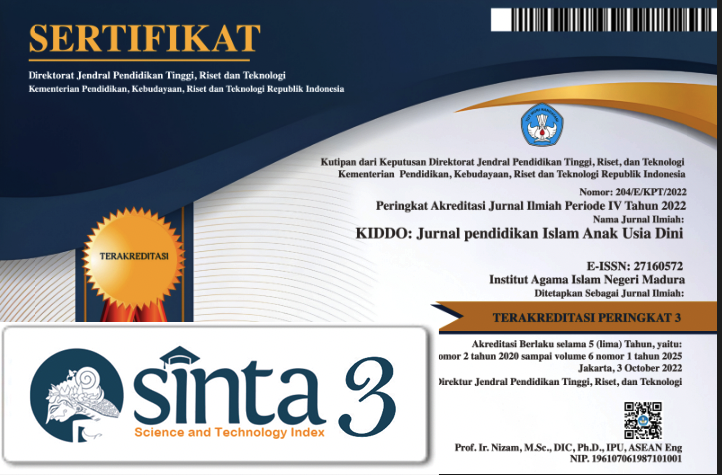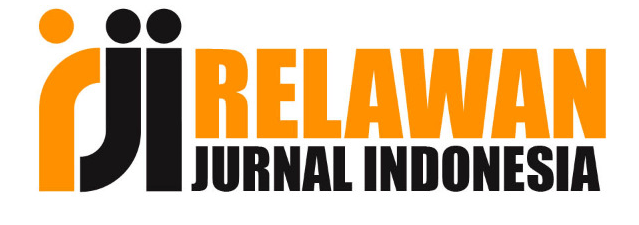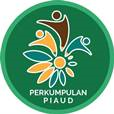The Role of Teachers in Creating a Child-Friendly School at TK Negeri Pembina Gianyar Bali
 Abstract views: 93
,
Abstract views: 93
,
 PDF downloads: 52
PDF downloads: 52
Abstract
Early childhood education is the first formal education that young children attend. Children’s joyful experiences at this educational stage become crucial because they lay the foundation for a love of learning, a love of education, and lifelong learning. In 2015, the Indonesian Government initiated the program of “Sekolah Ramah Anak” (Children-Friendly School) to serve the right of children to gain knowledge at schools. Teachers possess important roles in Children Friendly Schools. The purpose of this study is to investigate the role of teachers in a Children-Friendly School, TK Negeri Pembina Gianyar - Bali. This research applies the qualitative-descriptive method. The research method used is qualitative, the purpose of this study uses qualitative research so that researchers can describe a that occurs such as the role of teachers in child-friendly schools. The sample in this study was 11 teachers with a minimum teaching experience of 5 years. Data collection techniques in this study used interviews. Data analysis in this study was carried out through the stages of data reduction, data presentation, then conclusions (Miles and Huberman). The result explains that the teachers in TK Negeri Pembina Gianyar - Bali have various roles, such as facilitators, mentors, and motivators. They involve children, school staff, parents, and the community to establish a children-friendly environment.
Downloads
References
Bachtiar, M.Y. (2022). Pembelajaran berbasis Ramah Anak Taman Kanak-kanak di Kecamatan Bontotiro Kabupaten Bulukumba. Jurnal Instruksional, 1(2), 131-142
Chasani, M.T. (2022). The Concept of Teachers and Its Scope. Jurnal Ilmiah Pendidikan Holistik (JIPH), 1(3), 241-256
Cheruto, G., Allida, D., & Amimo, C. (2021). Implementation of Child Friendly School Programs in Schools as Perceived by Teachers and Learners from Public Primary Schools in Chesumei Sub-County, Kenya. Journal of Research Innovation and Implications in Education, 5 (1), 11- 22.
Cobanoglu, F., & Sevim, S. (2019). Child-friendly schools: An assessment of kindergartens. International Journal of Educational Methodology, 5(4), 637-650.
Fitriani, S. (2020). Promoting Child-Friendly School Model through School Committee as Parents' Participation. International Journal of Evaluation and Research in Education, 9(4), 1025-1034.
Fitriani, S., & Qodariah, L. (2021). A Child-Friendly School: How the School Implements the Model. International Journal of Evaluation and Research in Education, 10(1), 273-284.
Husni, Cristinita, dkk. (2020). Pedoman Sekolah Ramah Anak. Deputi Tumbuh Kembang Anak.
Infurna, Charles J. (2020). What Makes A Great Preschool Teacher? Best Practices and Classroom Quality in an Urban Early Childhood Setting. International Electronic Journal of Elementary, 13(2), 227-239
Marno and Fitriah N. (2022). Total Transformative Learning Model in Child Friendly School. Al-Tanzim: Jurnal Manajemen Pendidikan Islam, 6(03), 856-867
Marwanto. (2021). The Role Of The Teacher As A Facilitator In The Use Of Indonesian In Elementary School. STAINU Purworejo: Jurnal As Sibyan Jurnal Kajian Kritis Pendidikan Islam dan Manajemen Pendidikan Dasar, 4(1), 1-10.
Princess, Rahmi. (2023). The Role of Teachers in Child-Friendly School Programs di SDIT An-Nur Kab. Muara Jambi. At-Tarbawi. Journal of Education, Social, and Culture, 10 (1) 42-61.
Saleem, A., Shaheen, I., & Zahid, H. (2020). Assessment Of Child-Friendly Environment In Public Schools. PalArch's Journal of Archaeology of Egypt/Egyptology, 17(9), 9535-9556.
Sari, Mega Wulan, et.al. (2021). Peran Guru dalam Penerapan Sekolah Ramah Anak di TK YKK 1 Bangkalan. Jurnal PG-PAUD Trunojoyo. Jurnal Pendidikan dan Pembelajaran Anak Usia Dini, 8(1), 8 - 14.
Syahroni. (2022). The Effectiveness of Child-Friendly Schools on the Character of Learners. JOSR Journal of Social Research, 1(12), 681-688
Thivasenikumari A/P Viswanathan and Mohd Nazri Abdul Rahman. (2024). The Role of Preschool Teachers in Enhancing Imaginative Free-Play Activities in Preschool. Jurnal UPI - Cakrawala Dini: Jurnal Pendidikan Anak Usia Dini, 15 (1), 1-6.
UNICEF. (2006). Child-Friendly Schools Manual.
Wulandari H, & Afifah J N. (2023). Bullying Hingga Kekerasan, Masa Depan Anak Usia Dini Mulai Terancam. Jurnal Ilmiah Wahana Pendidikan, Vol 9 (16), 325-336
Wulandari H, & Rahmawan D P. (2022). Peran Guru Dalam Mewujudkan Lingkungan Belajar Yang Ramah Anak. Jurnal Ilmiah Wahana Pendidikan 9(16), 385-392
Wulan, S., & Fridani, L. (2021). Teaching Strategy in Early Childhood Education: Child-Friendly Classroom Management to Anticipate Bullying Behaviours. Jurnal Pendidikan Usia Dini, 15(2), 379-394.
Copyright (c) 2024 Noviarta Briliany, Anak Agung Ari Laksemi

This work is licensed under a Creative Commons Attribution 4.0 International License.
-
The journal operates an Open Access policy under a Creative Commons 4.0 International license. The terms of the license are:
Share— copy and redistribute the material in any medium or format
Adapt— remix, transform, and build upon the material for any purpose, even commercially.
1. Authors retain copyright and grant the journal right of first publication with the work simultaneously licensed under a Creative Commons License.that allows others to share the work with an acknowledgement of the work’s authorship and initial publication in this journal
2. Authors are permitted and encouraged to post their work online (e.g., in institutional repositories or on their website) prior to and during the submission process, as it can lead to productive exchanges, as well as earlier and greater citation of published work (See The Effect of Open Access).
Jurnal Kiddo is licensed under a Creative Commons
n Access).














